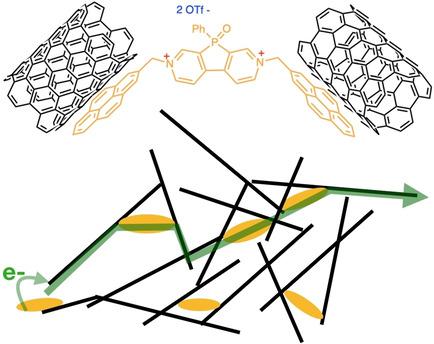当前位置:
X-MOL 学术
›
Batteries Supercaps
›
论文详情
Our official English website, www.x-mol.net, welcomes your feedback! (Note: you will need to create a separate account there.)
Phosphaviologen‐Based Pyrene‐Carbon Nanotube Composites for Stable Battery Electrodes
Batteries & Supercaps ( IF 5.7 ) Pub Date : 2019-12-19 , DOI: 10.1002/batt.201900164 Colin R. Bridges 1 , Monika Stolar 1 , Thomas Baumgartner 1
Batteries & Supercaps ( IF 5.7 ) Pub Date : 2019-12-19 , DOI: 10.1002/batt.201900164 Colin R. Bridges 1 , Monika Stolar 1 , Thomas Baumgartner 1
Affiliation

|
The adoption of intermittent renewable power sources has placed battery technologies into the limelight, initiating a push to develop sustainable materials for energy storage that do not rely on rare or toxic elements. Organic electrode materials are made from abundant elements that are consumed in the biomass cycle, which can make large‐scale manufacturing and recycling of these materials less detrimental to the environment. Herein, we explore how organic, electroactive phosphoryl‐bridged viologens (phosphaviologens) can be composited with single‐walled carbon nanotubes (SWCNTs) and used as organic electrodes composed of sustainable/abundant materials. To this end, we have functionalized phosphaviologens that exhibit two stable and reversible reductions with pendant pyrene moieties to interface them with carbon nanotubes. The anchoring of the redox active species on the surface of SWCNTs prevents electrode dissolution, and hybrid batteries with a high voltage (1.95–3.5 V) vs. Li/Li+ using phosphaviologens as the cathode remain stable past 500 charge/discharge cycles.
中文翻译:

用于稳定电池电极的基于磷紫罗兰的Car碳纳米管复合材料
间歇性可再生能源的采用使电池技术成为人们关注的焦点,从而开始推动开发不依赖稀有或有毒元素的可持续能源存储材料。有机电极材料是由生物质循环中消耗的大量元素制成的,这可以使这些材料的大规模生产和回收对环境的损害较小。在本文中,我们探讨了如何将有机电活性磷酰基桥接紫精(磷酸卵磷脂)与单壁碳纳米管(SWCNT)复合,并用作可持续/丰富材料组成的有机电极。为此,我们已经官能化了磷酸卵磷脂,它们通过pendant侧基与碳纳米管相接,表现出两个稳定且可逆的还原反应。+使用磷光气原作为阴极,经过500次充电/放电循环后仍保持稳定。
更新日期:2019-12-19
中文翻译:

用于稳定电池电极的基于磷紫罗兰的Car碳纳米管复合材料
间歇性可再生能源的采用使电池技术成为人们关注的焦点,从而开始推动开发不依赖稀有或有毒元素的可持续能源存储材料。有机电极材料是由生物质循环中消耗的大量元素制成的,这可以使这些材料的大规模生产和回收对环境的损害较小。在本文中,我们探讨了如何将有机电活性磷酰基桥接紫精(磷酸卵磷脂)与单壁碳纳米管(SWCNT)复合,并用作可持续/丰富材料组成的有机电极。为此,我们已经官能化了磷酸卵磷脂,它们通过pendant侧基与碳纳米管相接,表现出两个稳定且可逆的还原反应。+使用磷光气原作为阴极,经过500次充电/放电循环后仍保持稳定。

























 京公网安备 11010802027423号
京公网安备 11010802027423号